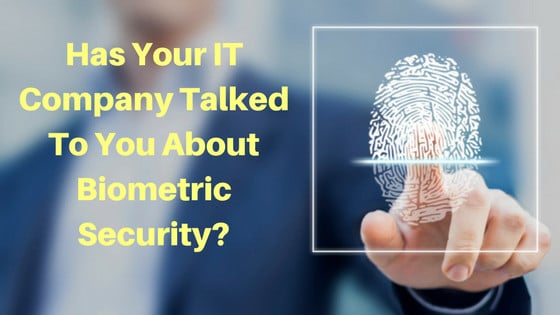If you’ve paid any attention to computer security in the past few years, you know how quickly biometrics is being adopted.

Biometrics refers to the used of biological data for security. While passwords can be guessed or hacked, physical characteristics like fingerprints are much more difficult to fake. This helps to protect against a wide variety of security threats.
And, biometrics isn’t just for government agencies or high-tech companies. Thanks to price reductions and more innovative applications, biometrics has become a choice for many small and mid-sized businesses. The following are some ways businesses use biometrics to enhance their security.
Fingerprint Scanning
Fingerprint scanning was always going to do well in the consumer market. It’s easy to use, doesn’t take up much room (the latest phones combine an activation button and scanner into one feature), and is relatively inexpensive to mass-produce. For businesses that want to retrofit their computer devices, fingerprint scanners come as affordable USB accessories that can be attached to desktops.
The end result is a simple biometric login, with minimal investment – which is exactly the sort of security that growing companies need. Many businesses are now requiring biometric logins on devices instead of passcodes or other methods.
However, employee guidelines and administrator controls must be very clear on this point— Employees must be trained to turn off or log off devices every time they’re finished using a computer. Fingerprint scanners are good security options if computers are left unattended and logged in – This is a great way to encourage in-person theft.
Facial ID
Facial ID is an interesting twist on biometric data collection, and may even be replacing touch-based ID in some technologies. It works in computers and mobile cameras that can scan facial features with an infrared beam and convert that information into data. The scans are surprisingly accurate as long as the camera is at the right angle to get a good look at your face. (Even hats and hairstyles rarely fool them!)
Individual reaction to facial ID has been mixed— It’s a new technology, and some fear these devices will “watch” and record facial information. Fortunately, these scans don’t work this way. But, most people are now more comfortable with computers recognizing their faces, voices, etc. Today, common devices like Microsoft laptops come with built-in facial- recognition technology.
On the commercial side, it’s still uncertain how widespread facial ID will be used. It’s more expensive and less available than fingerprint scanning, so small companies may not have many reasons to consider it. However, commercial organizations that have used iris recognition in the past are very interested in facial scans. It’s an affordable alternative that provides the same level of security.
Biometric Time Clocks
When it comes to specific applications, the new trend for biometrics is changing how time sheets are created. Biometric time clocks require an in-person, direct login and logout at specified times. They are difficult to change or cheat, and can be applied to all employees equally.
Currently, vendors are marketing biometric time clocks as a solution for industries with a lot of turnover, and where keeping time sheet recording honestly is an ongoing problem. This is primarily a concern for large organizations and those looking to scale up. Right now, biometric time clocks don’t have as many applications for small businesses.
Biometrics at Point of Sale (POS)
Here’s a trend that companies of all sizes should be interested in. This has massive security implications—It makes certain types of identity theft impossible, and allows for better recording of transactions and customer data.
In the past customers weren’t about to accept biometrics at the checkout counter. Fortunately, POS systems have evolved. We’re now used to making mobile payments with our phones (which typically require a quick sign-in), dealing with self-checkout, and generally taking a more active role in the payment process.
In some cases, a biometric login to authorize payments can be a lot quicker than pulling out a card or typing in identification information. As a result, you can expect to see biometrics incorporated into POS more frequently in the coming years.
Tailored Data Access Control
Data access is at the heart of biometrics security. And that’s where it comes in handy for nearly any business. It provides the ability to draw a line and block or authorize data access. Administrators have long grappled with the best ways to implement access control while still making workflow as fast and flexible as possible.
Today biometric data control is being incorporated into most advanced solutions. Once it’s used for company security, incorporating it into access controls is the next logical step. Keep in mind that any business can benefit from this, not just security firms and large corporations.
Biometric App Management
Here’s the thing about trendy technology—A a lot of new players get into the game, and the market can quickly get saturated with a long list of apps and solutions to pick from. For most companies, the struggle lies in finding the right or properly licensed biometrics software to use for their particular situation. Picking one at random isn’t advised.
If you’d like help selecting a biometrics solution or finding the right way to implement one, we can assist. CleverPath IT helps growing businesses in Wyoming and surrounding areas use the right data services for their unique needs. Contact us via [email protected] or (888) 686-3025.

 Mon-Fri 8 AM to 6 PM Mountain
Mon-Fri 8 AM to 6 PM Mountain 888-686-3025
888-686-3025



